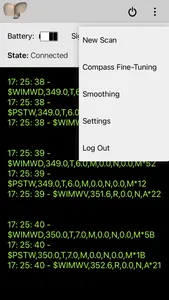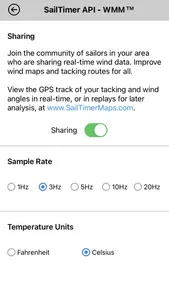An API is a digital toolkit; this one handles the Bluetooth 4 LE connection to the SailTimer Wind Instrument - WMM Edition™ (SailTimerWind.com).
You can let this app run in the background. It hands off the wind data to other wind gauge or chartplotting apps for display (even if the screen is turned off to conserve power). It converts wind data from magnetic to true north, from Apparent to True, from wind direction to angle, and to NMEA 0183 marine electronics format. Streaming data is shown in green text as the wireless data arrives from the Wind Instrument to show you when the connection is made. There is a Pause/Play button in the upper right of the green text.
The app uses the sophisticated new NOAA-British Geological Survey geomagnetic model for compass declination (the angle between Magnetic and True North), since magnetic north has been moving around faster than usual in recent years. The Wind Instrument can also get over-the-air updates with this app, for new electronics functions that may become available in future.
After scanning for your Wind Instrument, you can rename it with an identifier like your boat name. No-one else can see this, but it ensures that you are connecting to your own Wind Instrument in a marina. The app reconnects to yours from then on.
The API tries to reconnect automatically if the Bluetooth signal is lost. In the upper right corner there is also a circular Dis/Connect button. That is handy when leaving the boat, or also if you want to save power in the iOS device and in the Wind Instrument when not in use. Your iPad/iPhone also use less power when the GPS (Location Services) and Bluetooth are shut off with the Disconnect button. Continued use of GPS running in the background can dramatically decrease battery life. This app may use your location even when it isn’t open, which can decrease device battery life.
Logging in gives you the option to display wind conditions at your location online. That is handy if you want to share your location with others for safety. And if you want to check wind conditions and temperature at your boat from home. You can Register the first time in the API or at SailTimerMaps.com. Then you can simply log in to the API, and you won’t have to log out or log in again.
The Settings menu also lets you set the transmission rate to 1, 3 or 5 times per second (Hz). Wind gauges move more smoothly with faster transmissions, but numerical displays may change too fast. You may want fast transmissions for an autopilot, or may prefer to conserve battery power in your Wind Instrument with fewer transmissions.
There is a Smoothing option over the number of transmissions per second. Increase this damping if a wind display is too jumpy (especially at faster transmission rates) because of mast vibration, boat pitching etc. More information on this in the SailTimer newsletters at http://eepurl.com/huv5cD and http://eepurl.com/hDWhdX.
There is also an advanced function for Compass Quadrant Fine-Tuning. This is rarely needed, but gives you the ability to fine-tune the precise degrees for North, East, South and West where the Wind Instrument is mounted on your boat (e.g. because of magnetic deviation from nearby objects).
Simulator for testing True Wind Direction (TWD) and True Wind Speed (TWS): Long-tap on the wind cup icon to start. Double-tap on the wind cup icon to stop. Allows you to enter boat speed and heading and apparent wind speed and direction, and check TWD and TWS in the first line of green text (MWD in NMEA0183 format).
For more accuracy and ease of use, Apparent Wind Direction (AWD) is displayed for True Wind Direction (TWD) if GPS speed less than 2 knots. AWD and TWD should be the same then. This prevents TWD from fluctuating because of GPS resolution when you are not moving.
*If you are getting the app and like this wireless technology, please help out other sailors by letting them know, with a quick rating on this version while you’re here.
You can let this app run in the background. It hands off the wind data to other wind gauge or chartplotting apps for display (even if the screen is turned off to conserve power). It converts wind data from magnetic to true north, from Apparent to True, from wind direction to angle, and to NMEA 0183 marine electronics format. Streaming data is shown in green text as the wireless data arrives from the Wind Instrument to show you when the connection is made. There is a Pause/Play button in the upper right of the green text.
The app uses the sophisticated new NOAA-British Geological Survey geomagnetic model for compass declination (the angle between Magnetic and True North), since magnetic north has been moving around faster than usual in recent years. The Wind Instrument can also get over-the-air updates with this app, for new electronics functions that may become available in future.
After scanning for your Wind Instrument, you can rename it with an identifier like your boat name. No-one else can see this, but it ensures that you are connecting to your own Wind Instrument in a marina. The app reconnects to yours from then on.
The API tries to reconnect automatically if the Bluetooth signal is lost. In the upper right corner there is also a circular Dis/Connect button. That is handy when leaving the boat, or also if you want to save power in the iOS device and in the Wind Instrument when not in use. Your iPad/iPhone also use less power when the GPS (Location Services) and Bluetooth are shut off with the Disconnect button. Continued use of GPS running in the background can dramatically decrease battery life. This app may use your location even when it isn’t open, which can decrease device battery life.
Logging in gives you the option to display wind conditions at your location online. That is handy if you want to share your location with others for safety. And if you want to check wind conditions and temperature at your boat from home. You can Register the first time in the API or at SailTimerMaps.com. Then you can simply log in to the API, and you won’t have to log out or log in again.
The Settings menu also lets you set the transmission rate to 1, 3 or 5 times per second (Hz). Wind gauges move more smoothly with faster transmissions, but numerical displays may change too fast. You may want fast transmissions for an autopilot, or may prefer to conserve battery power in your Wind Instrument with fewer transmissions.
There is a Smoothing option over the number of transmissions per second. Increase this damping if a wind display is too jumpy (especially at faster transmission rates) because of mast vibration, boat pitching etc. More information on this in the SailTimer newsletters at http://eepurl.com/huv5cD and http://eepurl.com/hDWhdX.
There is also an advanced function for Compass Quadrant Fine-Tuning. This is rarely needed, but gives you the ability to fine-tune the precise degrees for North, East, South and West where the Wind Instrument is mounted on your boat (e.g. because of magnetic deviation from nearby objects).
Simulator for testing True Wind Direction (TWD) and True Wind Speed (TWS): Long-tap on the wind cup icon to start. Double-tap on the wind cup icon to stop. Allows you to enter boat speed and heading and apparent wind speed and direction, and check TWD and TWS in the first line of green text (MWD in NMEA0183 format).
For more accuracy and ease of use, Apparent Wind Direction (AWD) is displayed for True Wind Direction (TWD) if GPS speed less than 2 knots. AWD and TWD should be the same then. This prevents TWD from fluctuating because of GPS resolution when you are not moving.
*If you are getting the app and like this wireless technology, please help out other sailors by letting them know, with a quick rating on this version while you’re here.
Show More



